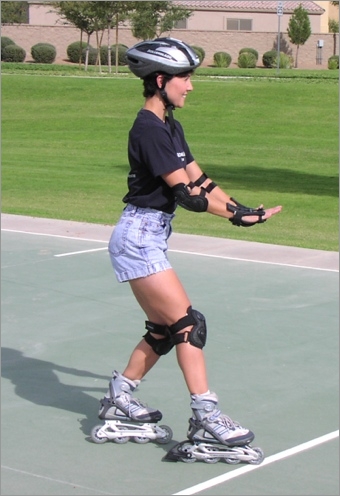 | ||
| ||||||||
By Kathy McSparran
Kathy McSparran demonstrates the scissors position for inline skaters. 1. Use It or Lose It Keep your head up and remain alert at all times. If you don't have your eyes open, you won't be able to react to those obstacles — small and large —that come your way. 2. Attack Hazards with Scissors When the trail gets rough, use the scissor position. Push one skate forward and the other back. Use the scissor position to negotiate rough pavement, gravel or small twigs. It gives you more stability. If what you're rolling over is slowing you down, shift your weight to your back skate. This will keep you from pitching forward over your toe wheels. 3. Water Hazards Avoid wet surfaces. Sometimes they are skate-able, sometimes they are not. The smoother the surface, the more dangerous when wet. (A newly mopped floor at a grocery store could easily launch you through a few display racks.) If you must cross a wet surface, skate easy until your wheels stop leaving wet stripes behind you. Avoid standing water. If it gets in your bearings, they'll probably rust. 4. Climbing Kilimanjaro When skating uphill, point your toes out so your feet form a "V" and maintain your forward momentum with short quick strides. 5. Downhill Danger Don't start rolling downhill unless you are sure you can handle the speed. Hills are deceptive and dangerous for inline skaters. What looks easy from the top can be disastrous halfway down. Don't risk it. Before you go down, size up the hill. Is the pavement good? Is there a curve or an intersection at the bottom? Just how steep is the hill? If you have any doubts, walk down the hill first. Then, starting from the bottom, attack the hill by fractions. Climb a few yards up the hill. Then turn around and roll down. If that feels OK and if you were in complete control at all times, skate up a little higher and roll down again. Keep going until until you reach the top of the hill or the end of your comfort zone. Whatever you do, don't take chances on hills. Falls on downhills can be particularly nasty. 6. Miss Manners Skate to the right, pass on the left. That's basic trail etiquette. Say "passing on the left" when approaching someone from behind. And smile. Be an ambassador for skating so we will continue to be welcomed on trails and elsewhere. 7. Nice Doggie? Even a small dog can prove hazardous. All it has to do is jump out in front of you — or stretch its leash across the trail — to send you flying. When you see a dog approaching, slow down. Smile and make eye contact with the owner (if there is one). The owner will likely respond by shortening the dog's leash or otherwise showing you that Fido is under control. If the dog is unleashed or beyond the control of the owner, stop skating or step off the trail onto gravel or grass. That way if the little bugger jumps on you, your wheels won't roll out from under you. 8. Snakes and Stuff Beware of wires, hoses, cables and ... yes, even snakes. I have encountered all of these — and more — at one time or another. Beginners should stop and step around such obstacles. Intermediates can leap over them one foot at a time. Advanced skaters can jump over them ... except for the snakes. Give them a wide berth! 9. Scouting Party
I realize that bicycles represent a backward stage in the evolution of wheeled transportation. Nonetheless, I endorse the use of these anachronistic devices when scouting new skate routes or trails. Astride one of these sturdy (if lumbering) contraptions, skaters can survey new trails for hazards, such as broken pavement, sprinkler-borne puddles and precipitous downhills. 10. Whiny Skates When your skates talk, listen! And always carry a multipurpose skate tool for roadside repairs. Grinding sounds may be a sign of worn or dirty bearings. Rattling may be a sign of a loose axle, wheel or frame bolt ... or maybe it's that snake again! --- Kathy McSparran is the former director of Phoenix Inline, an Arizona skate school. She holds five IISA teaching certifications: Level 1 (Beginners & Advanced Beginners), Level 2 (Intermediates & Advanced Intermediates), BladeFitnessTM, Freestyle Dance and Fitness Inline Trainer.
Related reading: • Skate Tip of the Week Archive
...
Copyright © 2010 Inline Planet | ||||||||


